IDEX Online Research: Executive Compensation - No Fat Wallets for Jewelers This Year
November 17, 09
In 2010 – for the third year in a row – compensation levels for the jewelry industry’s top executives probably won’t rise. And if compensation consultants’ outlooks are to be believed, rank-and-file employees probably won’t receive a pay raise, either.
Here are the highlights of a compensation study conducted by IDEX Research for jewelry executives of publicly held companies.
- The typical chief executive officer of a publicly held company receives total cash compensation of 0.1-0.2 percent of total corporate revenues. We note that Tiffany’s CEO earns only 0.03-0.04 percent or one-tenth of some other CEOs of public companies. In contrast, the typical owner of an independent specialty jewelry store receives total compensation of about 8 percent of revenues.
- Cash compensation for top jewelry executives was flat to slightly down in 2008, while total compensation including benefits and stock options was generally down significantly.
- CEOs cash salaries were mostly flat or down slightly in 2008. Typically, cash compensation is spelled out in employment contracts, and it represents a “base compensation” level that does not vary significantly.
- Other parts of the typical CEO’s pay package were down substantially, since they are typically related to performance. Most top officers of publicly held companies received significantly less total compensation – salary, bonus, stock options, and other benefits – in 2008 (or fiscal periods that included most of 2008) than in the prior year.
- Almost no publicly held jewelry companies have paid bonuses to their top executives in the past two years, unless it was contractually guaranteed.
- Salaries of CEOs of publicly held jewelry companies tend to be on the lower end of the range for merchants at similar size companies in other retail categories.
- Chief financial officers’ cash compensation is typically about 40 percent of the cash compensation of the CEO, though there were a couple of companies that were outside of this range (one significantly lower and one significantly higher).
- There is a whole new set of executive titles in the jewelry industry. Historically, there would be the CEO, CFO, chief operating officer, chief merchandising officer, and often a chief technology officer or chief stores officer. Those titles are beginning to give way to titles such as “Chief Sourcing & Supply Chain Officer,” a title used by Zale. A similar title is used by Birks & Mayors.
Jewelry Demand Weak Since 2007
Jewelry demand began to wane in late 2007. In 2008, jewelry sales further softened, and by the holiday season they were down about 22 percent, year-over-year, for specialty jewelers. Despite the best budget planning possible, jewelry merchants’ profits all but evaporated in 2008.
Consumer demand in 2009 was a repeat of 2008, though the sales declines were not as steep. Profits have remained elusive.
In this environment, how can officers be compensated fairly? How should stellar employees be rewarded? Here’s a look at how the publicly held companies handled these delicate questions.
Public Companies Capped Salaries
Among the publicly held companies, the salaries of top executives were capped. Some companies – such as Lazare Kaplan – announced that top officers took pay cuts. Others have curbed “perks” – benefits that might be “nice” when sales and profits are growing, but are clearly non-essential during lean times.
Here is a recap of salaries paid by publicly held jewelry companies.
Tiffany & Company
While top executives’ salaries moved only slightly higher in 2008, their total compensation was down substantially. For example, CEO Mike Kowalski’s total compensation dropped by nearly 70 percent, as the result of weak financial performance related to the global recessionary environment. Every other corporate top officer at Tiffany also received substantially less total compensation in 2008 versus earlier years, as the table below illustrates.
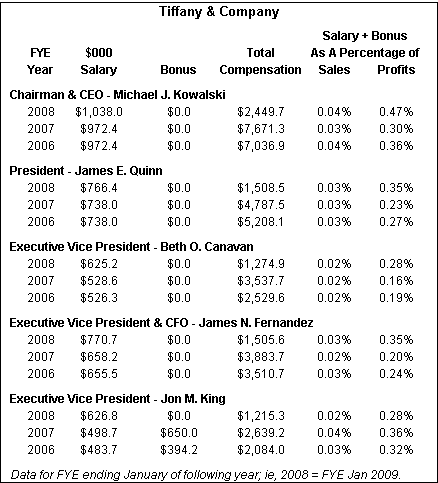
Source: Tiffany & Co. legal filings
Birks & Mayors
Because Birks & Mayors is headquartered in Canada, it is considered a foreign stock company. Management is required to file less legal and financial documentation than U.S. domiciled companies. Hence, the only compensation information reliably available and summarized in comparative form consists of cash salary and bonus. While stock compensation may be shown, it is not valued in the same way that a U.S.-based company’s total compensation is valued.
The compensation for Birks & Mayors executives represents only their cash compensation. At least one officer has departed the company since this table was constructed.
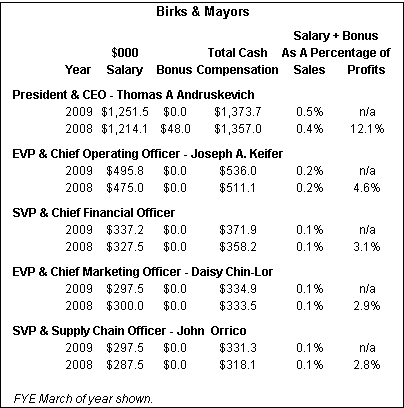
Source: Birks & Mayors legal filings
Harry Winston Diamonds is a company which is also considered a foreign stock company. It is subject to fewer disclosure requirements than U.S. based companies. Hence, we have shown only cash compensation for its top officers on the table below.
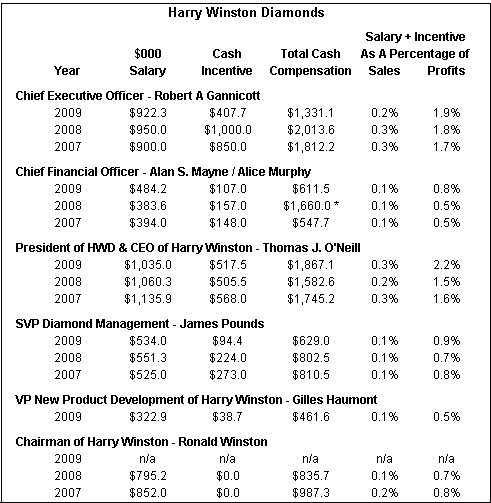
Source: Harry Winston Diamonds legal filings
Signet Group
Signet Group is also a foreign stock company for SEC reporting purposes. Its compensation information is restricted to the top two officers, and the total value of its compensation is not shown in the same form as for U.S. based companies. Signet’s results were strong enough for the fiscal year ended January 2009 for bonuses to be paid.
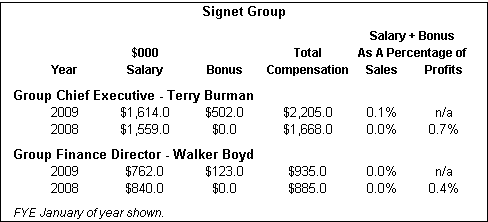 Source: Signet legal filings |
Zale Corporation
Zale has had above average turnover among its top officers. Neal Goldberg is the company’s fifth CEO in ten years. Other top-level jobs have had a number of people cycle through. The table below summarizes Zale’s compensation for its top officers for the past three years.
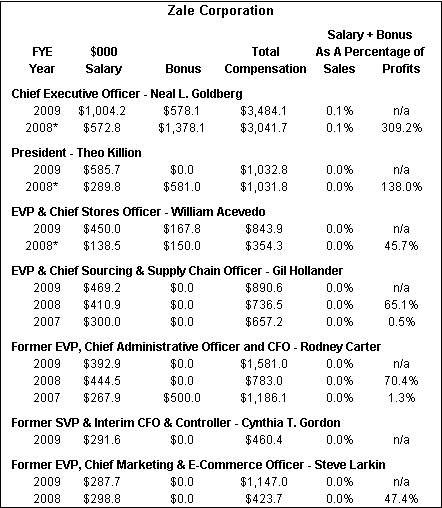
Source: Zale legal filings
The table below summarizes compensation for Zale’s CEOs since 1998. For the current fiscal year ending July 2010, Goldberg’s cash salary is set at $1.025 million, and his target bonus is 125 percent of that amount. Despite the company’s weak performance, Goldberg has received bonuses because of his employment contract. These guaranteed bonuses are one method directors use to lure a candidate into a dicey situation.
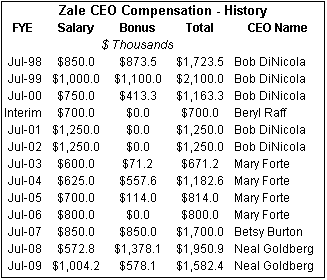 Source: Company reports |
Blue Nile
Blue Nile’s top officers have “put their money where their mouth is.” They are taking relatively modest cash compensation, but their total compensation is multiples higher than their cash compensation. Virtually all of the compensation beyond “cash compensation” is company stock in one form or another.
The table below summarizes total compensation levels for Blue Nile’s top officers.
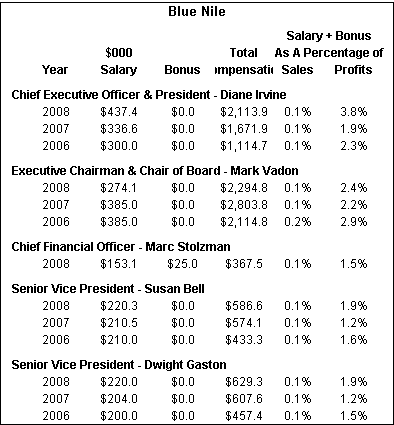
Source: Blue Nile legal filings
Movado Group
Times have been tough at Movado Group. Sales of fine watches have been particularly soft in the current recessionary environment. As a result, salaries have been capped, and total compensation has been reduced dramatically. The increase in the salary for the CFO relates to a new CFO – Sallie DeMarsillis – who took the job recently.
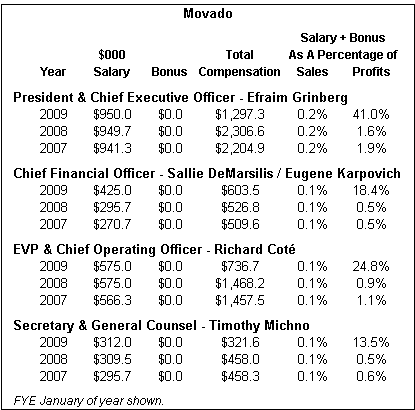
Source: Movado legal filings
Lazare Kaplan
Lazare Kaplan has been struggling with declining sales and evaporating profits. Salaries are down because management took pay cuts last year. Total compensation represents roughly the amount of cash compensation, since there have been no bonuses paid, either in cash or in kind via stock and options.
The table below summarizes the compensation for Lazare Kaplan’s top officers.
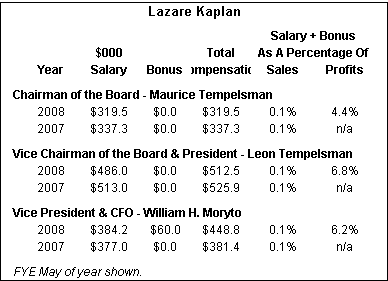
Source: Lazare Kaplan legal filings
Independent Specialty Jewelers
According to a recent InStore poll, the average owner’s compensation for an independent specialty jeweler is $85,404. Since the typical specialty jewelry store generates about $1.0-1.1 million in annual revenues, the average compensation is about 8 percent of total revenues. This is not an unreasonable level of compensation for a privately held specialty independent jeweler. However, it illustrates the disparity between the salaries of top chain executives – roughly 0.1 percent to 0.2 percent of revenues – versus independents who are saddled with much higher compensation levels relative to their sales.
Who Sets Executive Compensation?
A company’s board of directors determines the pay scale for the CEO and sometimes other top officers. How do the directors determine compensation? Securities & Exchange Commission rules have tightened the regulations. Essentially, compensation committees must follow a lengthy, complex process. Usually the company’s auditors help guide the committee, but there are compensation consultants who can help with the process.
Companies also use benchmark compensation levels at other public companies. For example, Blue Nile’s peer group consists of Knot, Inc., Shutterfly, Priceline.com, Netflix and similar companies. Zale Corporation uses a lengthy list beginning with Abercrombie & Fitch and ending with Williams-Sonoma, with companies such as American Eagle Outfitters, Gap, J.C. Penney, Kohl’s, Neiman Marcus Group, Pier 1 Imports and others also on the list. Compensation committees’ reports to shareholders were one or two pages just a decade ago; today those reports can be upwards of 15-20 pages.
Compensation of Corporate Directors
How much are corporate directors paid – those who make the decisions to pay the CEOs big bucks? Here’s a sampling of directors’ fees for public companies.
- Tiffany & Co. – Cash compensation for Tiffany directors ranges from $47,500 to $92,000 annually, depending on the number of committees they are on as well as which committees they chair. In addition, most of the directors received stock option awards of $164,000 (higher for a few board members), bringing their total annual compensation to as little as $212,000 or as much as $446,000. Tiffany noted that the annual retainer for a board member increased 50 percent this year, to $75,000 from $50,000. Committee chairs receive $15,000 to $20,000 additional fees. In addition, $2,000 is paid for each meeting attended in person, and $1,000 is paid for each telephonic meeting. Equity compensation and retirement benefits are also paid to directors; meeting expenses are reimbursed. Employees who are directors are not part of this compensation program; they are compensated differently.
- Zale Corporation – Directors at Zale received cash compensation from $49,000 to $106,000 in the most recent fiscal year ended July 2009. Their total compensation, including non-cash awards, ranged from $100,000 to $176,000, depending on which committees they served on.
During 2009, each non-employee director of Zale received quarterly retainer fees of $10,000. The Chairman of the Audit Committee received an additional annual retainer fee of $20,000. All other Committee Chairmen received an additional annual retainer fee of $10,000. Each non-employee director received a $1,500 fee for each board of directors meeting attended in person and a $1,000 fee for each board of directors meeting attended by telephone. Also, each committee member received $1,500 for each committee meeting attended in person and $1,000 for each committee meeting attended by telephone. Non-employee directors also received an annual award of restricted stock units with a grant date fair value of $50,000.
- Blue Nile – Blue Nile pays its outside directors an annual cash retainer of $40,000. In addition, it pays a $3,000 annual fee for service on any committee. The chairperson of the audit committee receives an additional $10,000 annual fee, while the chairs of other committees receive an additional $5,000 annual fee. Like their top executives, the directors of Blue Nile receive stock compensation which is worth multiples of their cash compensation. Last year, one of the directors received total compensation of just over $194,000; most directors received total compensation of just over $100,000, except for those who were either leaving the board or joining it, or had other special circumstances.
How to Handle Compensation in Tough Times
Whether the compensation is related to top executives or the rank-and-file, there are several broad trends in the market, including the following:
- Many companies are moving away from merit raises. Merit raises are often based more on tenure and less on productivity.
- Company executives need to keep employees informed about corporate financials. The news may be bad, but it is necessary to keep all employees informed, according to experts.
- Compensation should be based on performance. It is important for employees to know exactly what is expected of them.
- If compensation increases are not given, it may be possible to help staffers with some of their work-related expenses such as commuting, though this compensation may be taxable.